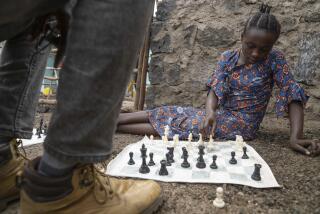Home Improvement : Boxes Make Game of Clearing Clutter
- Share via
Whether it’s early American or early Salvation Army, the decor of a child’s room improves if the clutter of toys and possessions is brought under control.
Parents can help make it happen by planning storage carefully.
Irene Richards of Norwalk, Conn., found that making a game out of cleanup time was the solution to keeping her two-year-old’s room in order.
She bought 15 lidded plastic storage containers in graduated sizes--small ones for tiny items such as character dolls and plastic parts, larger boxes for blocks and cars. Using nontoxic paints, she drew a picture of items to be stored in each of the plastic containers.
“At the end of the day, I say, ‘Let’s see if we can find the boxes and put all of our toys away.’ He treats finding the boxes and matching the toys to the pictures like a game,” she says.
This mother’s solution to the messy room problem is a good one, according to Barbara Gordon, head of the Whitby School in Greenwich, Conn. “It avoids making cleanup time into an us-against-them situation.”
If you choose containers children can lift and move around themselves, they’ll be more likely to use them. Safety dictates unbreakable containers of nontoxic materials with no sharp corners, says Gordon.
It is also more effective to have shelves at the child’s height and an arrangement which gives each thing its individual place. Having a large toy box used as a catchall is a tacit invitation to dump the contents into the middle of the room.
Children as young as two begin to have a sense of responsibility about picking up their things. “The educational theorist Maria Montessori writes that between the ages of 2 1/2 and four, children begin to enjoy being orderly,” Gordon says.
The age at which children develop an interest in the arrangement and decoration of their room is lower than usually imagined, according to Antonio F. Torrice, a California-based designer specializing in decorating for children’s spaces.
“When you give children as young as two or three a say in choosing colors or room arrangement, you teach them that they can influence their environment--a powerful learning experience that builds self-esteem,” says Torrice.
Needs change as a child grows up, but children of all ages generally use their bedrooms for play and study as well as for sleeping. All children need ample storage space to accommodate their possessions.
Having a lot of anything--toys, books or clothing--can be counterproductive. Too many choices makes self-sufficiency more difficult and children more careless of what they have. To help young children get the most out of their toys, put some out of sight, while making sure the others are readily accessible, suggests Gordon.
Convenience, accessibility and safety don’t have to be expensive, says Torrice. Discount-store plastic basins with hand-lettered labels on plain wooden shelves are every bit as functional as a custom-made storage unit. You can even turn sturdy paper cartons into holders for children’s possessions.


